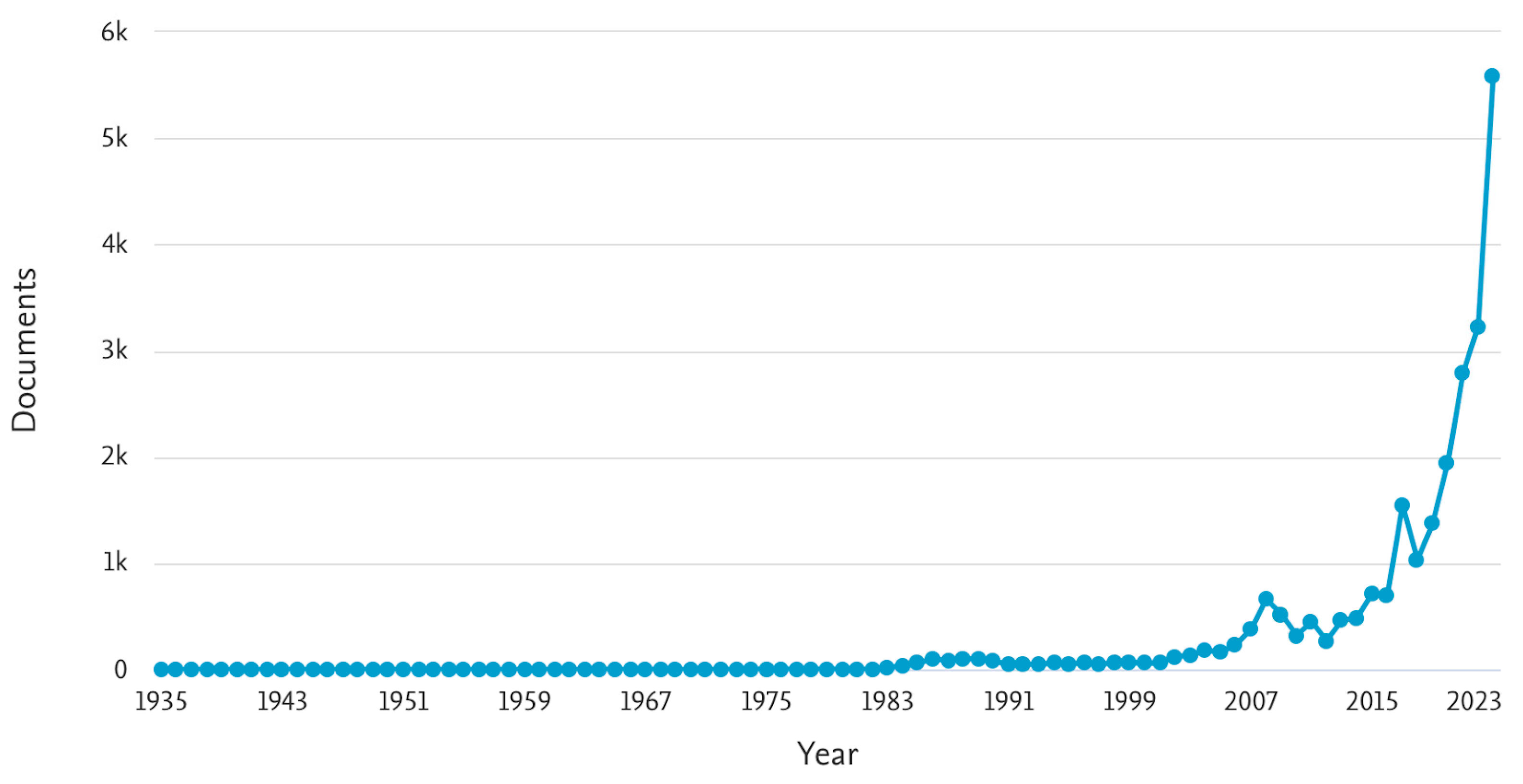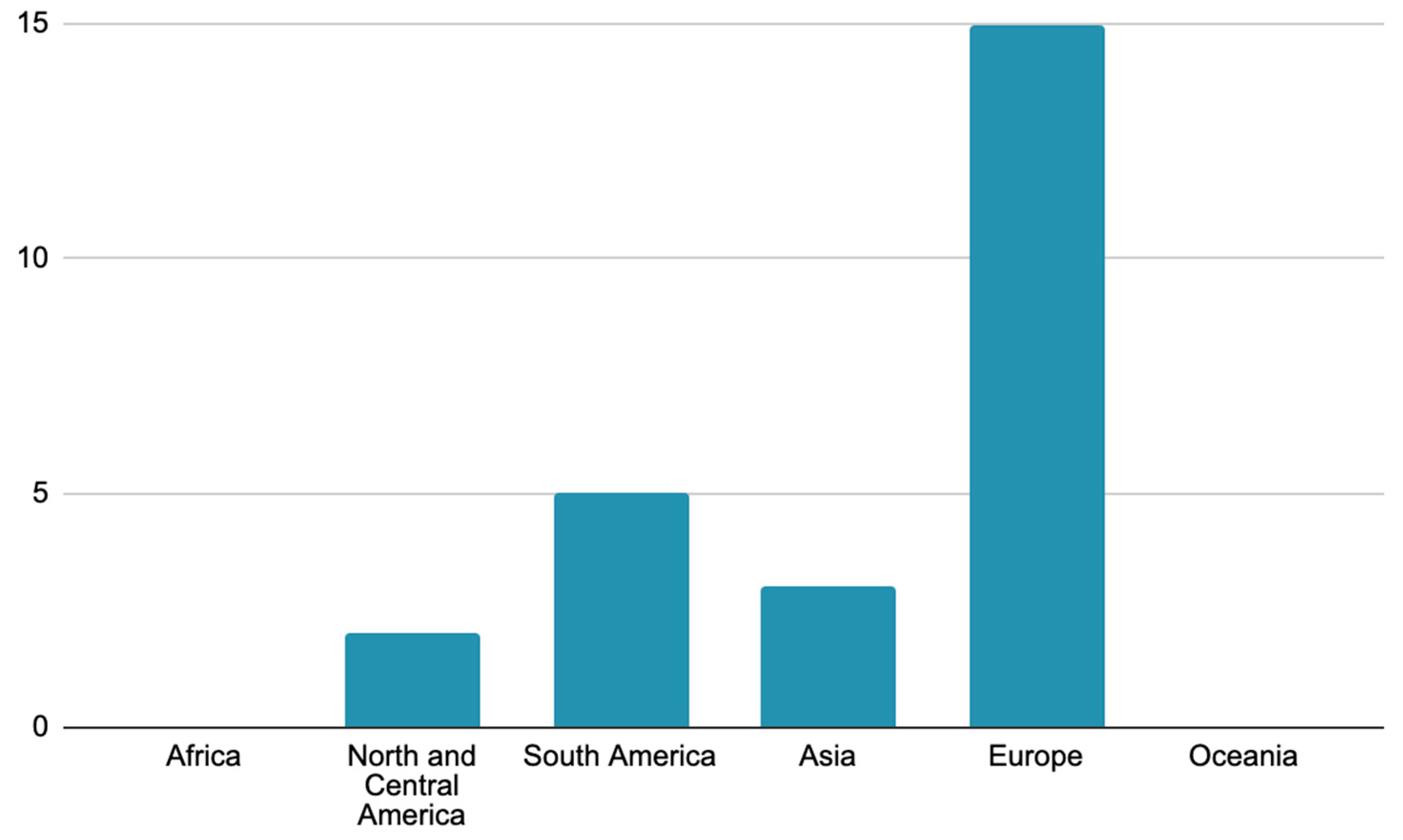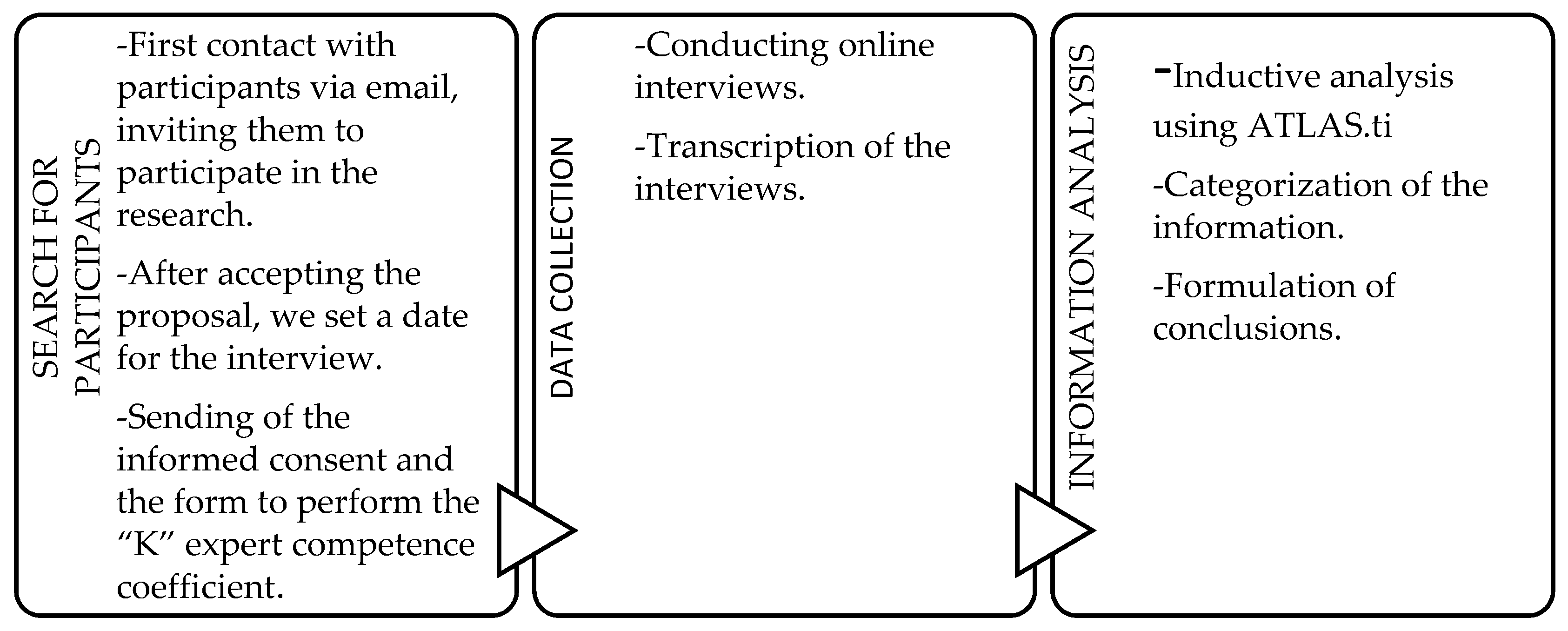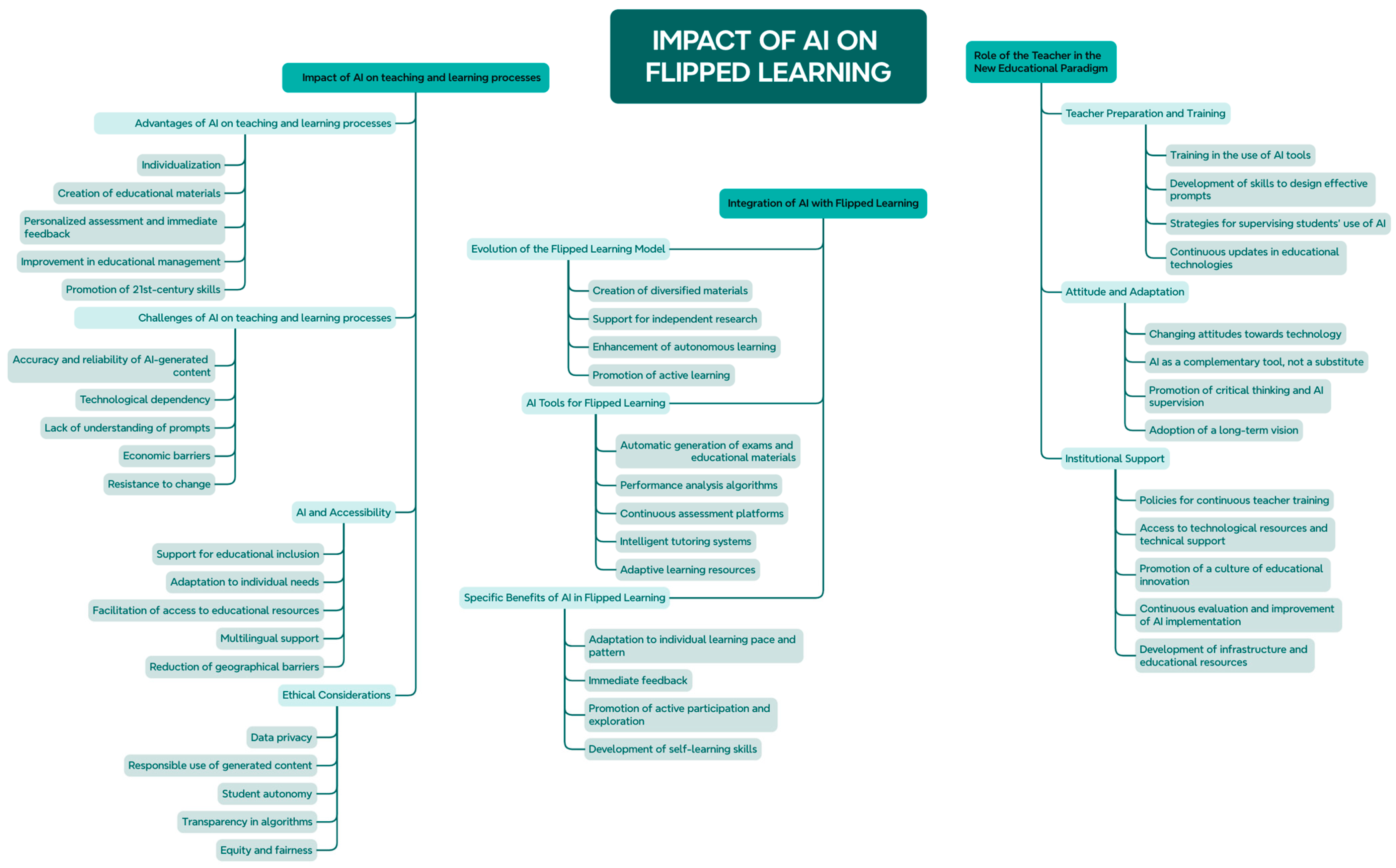Flipped Learning and Artificial Intelligence
Abstract
:1. Introduction
“Flipped Learning is a framework that enables educators to reach every student. The Flipped approach inverts the traditional classroom model by introducing course concepts before class, allowing educators to use class time to guide each student through active, practical, innovative applications of the course principles”[3].
1.1. Model Review
1.2. Study and Research Questions
- RQ1. What are the main advantages and challenges of integrating AI in education?
- RQ2. How can the Flipped Learning approach evolve with the help of AI?
- RQ3. What should the role of the teacher be in this new educational paradigm?
2. Methods
2.1. Participants and Data Collection
2.2. Data Analysis
3. Results
3.1. Impact of AI on Teaching and Learning Processes
3.1.1. Advantages of AI on Teaching and Learning Processes
“The essential thing is for the student to become the owner of their learning… We are working so that students can monitor and evaluate their progress, which turns out to be a great motivator. Constant feedback and conversations with students are fundamental in this process”(P16).
“I believe it is a powerful tool for the teacher as a source of content and also to validate the design of a course. For example, a teacher may need to review the syllabus and think that certain points should be included”(P14).
“The use of AI in educational activities can challenge students to formulate higher-order questions and engage in deeper and more meaningful learning”(P9).
3.1.2. Challenges of AI on Teaching and Learning Processes
“The use of AI offers advantages, such as saving time on routine tasks, but it also entails risks, some of which have already been identified and are being addressed by European Union regulations”(P18).
“Currently, the use of AI in education can provide certain advantages, but in the future, not using AI could mean a disadvantage for students”(P20).
“Students’ work contains errors because they still don’t know how to write prompts. So, I believe that what AI offers us is the possibility for them to structure their information requests, to know what they need”(P1).
“It is important for educators to overcome the fear of innovation and see technology as an ally in their teaching work. The key is to start with small steps and then expand and adapt educational practices over time”(P11).
3.1.3. AI and Accessibility
“This reminded me of a blind art history student I had. For him, we created tactile materials that allowed him to visualize works like ‘Las Meninas.’ Now, with AI tools that can describe images in text or audio, we can make learning more accessible for students with special educational needs”(P19).
3.1.4. Ethical Considerations
“It is important to recognize and declare when content has been generated or assisted by AI. This can be done through a notice or disclaimer indicating that the activity was created with AI and subsequently reviewed and adapted by a specific person to ensure its quality”(P22).
3.2. The Integration of AI in Flipped Learning
3.2.1. Evolution of the Flipped Learning
“Adaptive learning is a specific area where AI has shown promising results. Adaptive learning technologies use AI algorithms to continuously assess a student’s understanding and adjust the difficulty and type of content accordingly. This ensures that students are neither bored with material that is too easy nor overwhelmed by content that is too difficult”(P25).
“It’s not just about knowing how to ask good questions; the important thing is what you want your students to learn and what you want to investigate. If you ask pertinent questions and present significant challenges, the answers will be much more enriching”(P14).
3.2.2. AI Tools for Flipped Learning
“I use ChatGPT. It helps me create the content, which I can then customise for non-native English speakers in their first year at university. After generating the text, I use an app called Pick 3 to break it down, add images, and turn it into a video. To personalise these videos, I use ElevenLabs to clone my voice, creating a voiceover that maintains a personal connection with my students. This combination of ChatGPT, Pictory, and Eleven Labs has saved me countless hours in preparation”(P21).
“AI tools can help generate content by summarizing textbooks, creating visual aids, or even producing lecture videos with synthesized speech and animations. This support can alleviate the time and effort required for educators to prepare materials, allowing them to focus on facilitating in-class activities”(P25).
“There are different chatbots that simulate being a historical character. Asking the AI about specific events or their actions enhances student motivation and can help gain a deeper understanding of the society and culture of that time. Additionally, when students have to discern between information provided by the AI and traditional historical sources, they learn to critically evaluate information and formulate well-founded arguments”(P11).
“Needs analysis is another area where AI shines. Using tools like Google Forms, I gather information about students’ knowledge of AI and their use of tools. This data is then analyzed using ChatGPT, providing insights into their needs. This allows me to tailor my teaching strategies and resources to better meet the students’ needs.”(P23).
“Overall, the integration of AI into my teaching has revolutionized the flipped classroom approach, making it more efficient, interactive, and personalized”(P25).
3.3. Role of the Teacher in the New Educational Paradigm
3.3.1. Teacher Preparation and Training
“Many teachers are experimenting with AI without a systematic strategy or a clear objective for its application in the teaching-learning process. Recently, I read that a high percentage of university students already use artificial intelligence to carry out academic work, and this trend is spreading to secondary and high school education”(P18).
3.3.2. Attitude and Adaptation
3.3.3. Institutional Support
4. Discussion and Conclusions
5. Limitations
6. Implications
Author Contributions
Funding
Data Availability Statement
Conflicts of Interest
Appendix A
| Data | Results |
|---|---|
| Kc questions | |
| 0.892 |
| 0.884 |
| 0.896 |
| 0.876 |
| 0.900 |
| 0.940 |
| 0.912 |
| 0.956 |
| 0.876 |
| 0.936 |
| 0.900 |
| 0.868 |
| 0.840 |
| 0.840 |
| 0.760 |
| 0.864 |
| 0.876 |
| 0.796 |
| 0.832 |
| 0.856 |
| Average | 0.875 |
| Ka questions | |
| 0.510 |
| 0.720 |
| 0.750 |
| 0.600 |
| 0.930 |
| 0.610 |
| 0.780 |
| 0.570 |
| 0.490 |
| 0.640 |
| Total | 0.660 |
| Participant | Kc | Ka | K |
|---|---|---|---|
| P1 | 0.725 | 0.550 | 0.638 |
| P2 | 0.850 | 0.500 | 0.675 |
| P3 | 0.940 | 0.800 | 0.870 |
| P4 | 1.00 | 1.00 | 1.00 |
| P5 | 0.750 | 0.400 | 0.575 |
| P6 | 0.935 | 0.650 | 0.793 |
| P7 | 0.785 | 0.650 | 0.718 |
| P8 | 0.855 | 0.650 | 0.753 |
| P9 | 0.990 | 1.00 | 0.995 |
| P10 | 0.940 | 0.750 | 0.845 |
| P11 | 0.975 | 0.550 | 0.763 |
| P12 | 0.855 | 0.500 | 0.678 |
| P13 | 0.840 | 0.750 | 0.808 |
| P14 | 0.885 | 0.400 | 0.643 |
| P15 | 0.930 | 0.925 | 0.928 |
| P16 | 0.935 | 0.825 | 0.880 |
| P17 | 0.795 | 0.525 | 0.660 |
| P18 | 0.730 | 0.400 | 0.565 |
| P19 | 0.805 | 0.675 | 0.740 |
| P20 | 0.880 | 0.675 | 0.778 |
| P21 | 0.910 | 0.750 | 0.830 |
| P22 | 0.945 | 0.725 | 0.835 |
| P23 | 0.635 | 0.500 | 0.568 |
| P24 | 0.895 | 0.525 | 0.710 |
| P25 | 0.965 | 0.750 | 0.858 |
| Evaluation of Kc | Range of Values |
|---|---|
| High knowledge of the topic | K ≥ 0.8 |
| Medium knowledge of the topic | 0.5 ≤ K ≤ 0.8 |
| Low knowledge of the topic | K ≤ 0.5 |
| Evaluation of Ka | Range of Values |
| High influence of the sources | K ≥ 0.8 |
| Medium influence of the sources | 0.5 ≤ K ≤ 0.8 |
| Low influence of the sources | K ≤ 0.5 |
| Evaluation of K | Range of Values |
| High level of competence | K ≥ 0.8 |
| Medium level of competence | 0.5 ≤ K ≤ 0.8 |
| Low level of competence | K ≤ 0.5 |
References
- Talbert, R. Inverting the Linear Algebra Classroom. Primus 2014, 24, 361–374. [Google Scholar] [CrossRef]
- Birgili, B.; Seggie, F.N.; Oğuz, E. The trends and outcomes of flipped learning research between 2012 and 2018: A descriptive content analysis. J. Comput. Educ. 2021, 8, 365–394. [Google Scholar] [CrossRef]
- Academy of Active Learning Arts and Sciences [ALAS]. Updated Definition of Flipped Learning. 2018. Available online: https://aalasinternational.org/updated-definition-of-flipped-learning/ (accessed on 26 August 2024).
- Palau, R.; Santiago, R. Las metodologías activas enriquecidas con tecnología. UTE Teach. Technol. 2022, 1, 5–16. [Google Scholar] [CrossRef]
- Anderson, L.W.; Krathwohl, D. A Taxonomy for Learning, Teaching, and Assessing: A Revision of Bloom’s Taxonomy of Educational Objectives; Longman: London, UK, 2001. [Google Scholar]
- Marzano, R.J.; Kendall, J.S. The New Taxonomy of Educational Objectives; Corwin Press: Thousand Oaks, CA, USA, 2007. [Google Scholar]
- Biggs, J.; Collins, K. Evaluating the Quality of Learning: The SOLO Taxonomy; Plenum Press: New York, NY, USA, 1982. [Google Scholar]
- Santiago, R.; Bergmann, J. Aprender al revés: Flipped Learning 3.0 y Metodologías Activas en el Aula; Ediciones Paidós: Barcelona, Spain, 2018. [Google Scholar]
- Santiago, R.; Díez, A.; Andía, L.A. Flipped Classroom: 33 Experiencias que Ponen Patas Arriba el Aprendizaje; UOC: Barcelona, Spain, 2017. [Google Scholar]
- Palau, R.; Fornons, V. Flipped Learning y su distribución de los tiempos de aprendizaje: Una experiencia en educación secundaria. Pixel Bit/Pixel-Bit. 2022, 64, 235–264. [Google Scholar] [CrossRef]
- Palau, R.; Fuentes, M.; Mogas, J.; Cebrián, G. Analysis of the implementation of teaching and learning processes at Catalan schools during the COVID-19 lockdown. Technol. Pedagog. Educ. 2021, 30, 183–199. [Google Scholar] [CrossRef]
- Fornons, V.; Palau, R. Flipped Classroom en la asignatura de matemáticas de 3° de Educación Secundaria Obligatoria. Edutec Rev. Electrón. Tecnol. Educ. 2016, 55, a322. [Google Scholar] [CrossRef]
- Wang, H.; Jin, T. Mixed Teaching of “MATLAB Simulation and Application” Course Based on “Micro Course + Flipped Classroom”. In Proceedings of the 2019 3rd International Seminar on Education, Management and Social Sciences (ISEMSS 2019), Changsha, China, 19 July 2019. [Google Scholar] [CrossRef]
- Sengar, S.S.; Hasan, A.B.; Kumar, S.; Carroll, F. Generative Artificial Intelligence: A Systematic Review and Applications. arXiv 2024, arXiv:2405.11029. [Google Scholar] [CrossRef]
- You, X.; Li, M.; Xiao, Y.; Liu, H. The Feedback of the Chinese Learning Diagnosis System for Personalized Learning in Classrooms. Front. Psychol. 2019, 10, 1751. [Google Scholar] [CrossRef] [PubMed]
- Hwang, G.J.; Xie, H.; Wah, B.J.; Gašević, D. Vision, challenges, roles and research issues of Artificial Intelligence in Education. Comput. Educ. 2020, 1, 100001. [Google Scholar] [CrossRef]
- Lan, A.S.; Baraniuk, R.G. A Contextual Bandits Framework for Personalized Learning Action Selection. In Proceedings of the 9th International Conference on Educational Data Mining, Raleigh, NC, USA, 29 June–1 July 2016; pp. 424–429. Available online: https://www.educationaldatamining.org/EDM2016/proceedings/paper_18.pdf (accessed on 26 August 2024).
- López-Villanueva, D.; Santiago, R.; Palau, R. ¿Es el momento de la personalización del aprendizaje? Retos y oportunidades de la Inteligencia Artificial. Libro Actas FIET 2024 URV 2024, in press.
- Dan, L.; Mohamed, H.; Yue, Z. A review on the effect of integrating AI-based technology into flipped learning. Innov. Teach. Learn. J. 2023, 7, 41–50. [Google Scholar] [CrossRef]
- Liu, M.; Ren, Y.; Nyagoga, L.M.; Stonier, F.; Wu, Z.; Yu, L. Future of education in the era of generative artificial intelligence: Consensus among Chinese scholars on applications of ChatGPT in schools. Future Educ. Res. 2023, 1, 72–101. [Google Scholar] [CrossRef]
- Chaudhry, I.S.; Sarwary, S.A.M.; Refae, G.A.E.; Chabchoub, H. Time to Revisit Existing Student’s Performance Evaluation Approach in Higher Education Sector in a New Era of ChatGPT—A Case Study. Cogent Educ. 2023, 10, 2210461. [Google Scholar] [CrossRef]
- Marzuki, U.; Rusdin, D.; Indrawati, I. The impact of AI writing tools on the content and organization of students’ writing: EFL teachers’ perspective. Cogent Educ. 2023, 10, 2236469. [Google Scholar] [CrossRef]
- Tsai, M.; Ong, C.W.; Chen, C. Exploring the use of large language models (LLMs) in chemical engineering education: Building core course problem models with Chat-GPT. Educ. Chem. Eng. 2023, 44, 71–95. [Google Scholar] [CrossRef]
- Panaqué, C.R.; Castañón, C.B. La inteligencia artificial en la educación del siglo XXI: Avances, desafíos y oportunidades. Presentación. Educación 2024, 33, 5–7. [Google Scholar] [CrossRef]
- Núñez-Michuy, C.M.; Agualongo-Chela, L.M.; Vistin, J.M.V.; Quincha, M.L. La Inteligencia Artificial en la pedagogía como modelo de enseñanza. Rev. Mag. Las Cienc. 2023, 8, 120–135. [Google Scholar] [CrossRef]
- Adams, C.; Pente, P.; Lemermeyer, G.; Rockwell, G. Ethical principles for artificial intelligence in K-12 education. Comput. Educ. Artif. Intell. 2023, 4, 100131. [Google Scholar] [CrossRef]
- Álvarez-álvarez, C.; Falcon, S. Students’ preferences with university teaching practices: Analysis of testimonials with artificial intelligence. Educ. Technol. Res. Dev. 2023, 71, 1709–1724. [Google Scholar] [CrossRef]
- Bolaño-García, M.; Duarte-Acosta, N. Una revisión sistemática del uso de la inteligencia artificial en la educación. Rev. Colomb. Cirugía 2023, 39, 51–63. [Google Scholar] [CrossRef]
- Huang, A.Y.; Lu, O.H.; Yang, S.J. Effects of artificial Intelligence–Enabled personalized recommendations on learners’ learning engagement, motivation, and outcomes in a flipped classroom. Comput. Educ. 2023, 194, 104684. [Google Scholar] [CrossRef]
- Recker, J. Scientific Research in Information Systems: A Beginner’s Guide; Springer Nature: Berlin/Heidelberg, Germany, 2021. [Google Scholar]
- Etikan, I.; Musa, S.A.; Alkassim, R.S. Comparison of Convenience Sampling and Purposive Sampling. Am. J. Theor. Appl. Stat. 2016, 5, 1–4. [Google Scholar] [CrossRef]
- Herrera-Masó, J.R.; Calero-Ricardo, J.L.; González-Rangel, M.Á.; Collazo-Ramos, M.I.; Travieso-González, Y. El método de consulta a expertos en tres niveles de validación. Rev. Habanera Cienc. Méd. 2022, 21, e4711. Available online: http://scielo.sld.cu/scielo.php?script=sci_arttext&pid=S1729-519X2022000100014&lng=es&tlng=es (accessed on 26 August 2024).
- Brinkmann, S.; Kvale, S. Interviews: Learning the Craft of Qualitative Research Interviewing, 3rd ed.; Sage: Newcastle upon Tyne, UK, 2015. [Google Scholar]
- Denzin, N.K.; Lincoln, Y.S. The Sage Handbook of Qualitative Research; Sage Publications, Inc.: Sauzendoaks, CA, USA, 2018. [Google Scholar]
- Troncoso-Pantoja, C.; Amaya-Placencia, A. Entrevista: Guía práctica para la recolección de datos cualitativos en investigación de salud. Rev. La Fac. Med. 2017, 65, 329–332. [Google Scholar] [CrossRef]
- Creswell, J.W.; Creswell, J.D. Research Design: Qualitative, Quantitative, and Mixed Methods Approaches; Sage Publications: Sauzendoaks, CA, USA, 2017; p. 237. [Google Scholar]
- Zhang, K.; Aslan, A.B. AI technologies for education: Recent research & future directions. Comput. Educ. Artif. Intell. 2021, 2, 100025. [Google Scholar] [CrossRef]
- Zawacki-Richter, O.; Marín, V.I.; Bond, M.; Gouverneur, F. Systematic review of research on artificial intelligence applications in higher education—Where are the educators? Int. J. Educ. Technol. High. Educ. 2019, 16, 6. [Google Scholar] [CrossRef]
- Holmes, W.; Bialik, M.; Fadel, C. Artificial Intelligence in Education: Promises and Implications for Teaching and Learning; Center for Curriculum Redesign: Boston, MA, USA, 2019; Available online: https://www.researchgate.net/publication/332180327_Artificial_Intelligence_in_Education_Promise_and_Implications_for_Teaching_and_Learning (accessed on 26 August 2024).
- Holmes, W.; Porayska-Pomsta, K.; Holstein, K.; Sutherland, E.; Baker, T.; Shum, S.B.; Santos, O.C.; Rodrigo, M.T.; Cukurova, M.; Bittencourt, I.I.; et al. Ethics of AI in Education: Towards a Community-Wide Framework. Int. J. Artif. Intell. Educ. 2021, 32, 504–526. [Google Scholar] [CrossRef]
- Tuomi, I. The Impact of Artificial Intelligence on Learning, Teaching, and Education: Policies for the Future; Publications Office of the European Union: Luxembourg, 2018. [Google Scholar] [CrossRef]
- Bates, T.; Cobo, C.; Mariño, O.; Wheeler, S. Can artificial intelligence transform higher education? Int. J. Educ. Technol. High. Educ. 2020, 17, 42. [Google Scholar] [CrossRef]
- Celik, I.; Dindar, M.; Muukkonen, H.; Järvelä, S. The Promises and Challenges of Artificial Intelligence for Teachers: A Systematic Review of Research. TechTrends 2022, 66, 616–630. [Google Scholar] [CrossRef]
- Walter, Y. Embracing the future of Artificial Intelligence in the classroom: The relevance of AI literacy, prompt engineering, and critical thinking in modern education. Int. J. Educ. Technol. High. Educ. 2024, 21, 15. [Google Scholar] [CrossRef]
- Drugova, E.; Zhuravleva, I.; Aiusheeva, M.; Grits, D. Toward a model of learning innovation integration: TPACK-SAMR based analysis of the introduction of a digital learning environment in three Russian universities. Educ. Inf. Technol. 2021, 26, 4925–4942. [Google Scholar] [CrossRef]
- Chen, L.; Chen, P.; Lin, Z. Artificial Intelligence in Education: A Review. IEEE Access 2020, 8, 75264–75278. [Google Scholar] [CrossRef]
- Walkington, C.; Bernacki, M.L. Personalizing Algebra to Students’ Individual Interests in an Intelligent Tutoring System: Moderators of Impact. Int. J. Artif. Intell. Educ. 2018, 29, 58–88. [Google Scholar] [CrossRef]
- Zhai, X.; Yin, Y.; Pellegrino, J.W.; Haudek, K.C.; Shi, L. Applying machine learning in science assessment: A systematic review. Stud. Sci. Educ. 2020, 56, 111–151. [Google Scholar] [CrossRef]
- Luckin, R.; Holmes, W.; Griffiths, M.; Forcier, L.B. Intelligence Unleashed: An Argument for AI in Education; Pearson: London, UK, 2016; Available online: https://www.pearson.com/content/dam/corporate/global/pearson-dot-com/files/innovation/Intelligence-Unleashed-Publication.pdf (accessed on 26 August 2024).
- Dikilitaş, K.; Klippen, M.I.F.; Keles, S. A Systematic Rapid Review of Empirical Research on Students’ Use of ChatGPT in Higher Education. Nord. J. Syst. Rev. Educ. 2024, 2, 103–125. [Google Scholar] [CrossRef]
- Erbil, D.G. A Review of Flipped Classroom and Cooperative Learning Method Within the Context of Vygotsky Theory. Front. Psychol. 2020, 11, 1157. [Google Scholar] [CrossRef] [PubMed]
- Almasri, F. Exploring the Impact of Artificial Intelligence in Teaching and Learning of Science: A Systematic Review of Empirical Research. Res. Sci. Educ. 2024, 1–21. [Google Scholar] [CrossRef]
- González-Calatayud, V.; Prendes-Espinosa, P.; Roig-Vila, R. Artificial Intelligence for Student Assessment: A Systematic Review. Appl. Sci. 2021, 11, 5467. [Google Scholar] [CrossRef]
- Day, T. A Preliminary Investigation of Fake Peer-Reviewed Citations and References Generated by ChatGPT. Prof. Geogr. 2023, 75, 1024–1027. [Google Scholar] [CrossRef]
- Elkhatat, A.M. Evaluating the authenticity of ChatGPT responses: A study on text-matching capabilities. Int. J. Educ. Integr. 2023, 19, 15. [Google Scholar] [CrossRef]
- Seo, K.; Tang, J.; Roll, I.; Fels, S.; Yoon, D. The impact of artificial intelligence on learner–instructor interaction in online learning. Int. J. Educ. Technol. High. Educ. 2021, 18, 54. [Google Scholar] [CrossRef]
- Liu, M.; Huang, J. Piano playing teaching system based on artificial intelligence—Design and research. J. Intell. Fuzzy Syst. 2021, 40, 3525–3533. [Google Scholar] [CrossRef]
- Akinwalere, S.N.; Ivanov, V. Artificial Intelligence in Higher Education: Challenges and Opportunities. Bord. Crossing 2022, 12, 1–15. [Google Scholar] [CrossRef]
- Bi, X.; Ye, S. The Application of Flipped Classroom Information Technology in English Teaching in the Context of 6G Network. Int. J. Inf. Commun. Technol. Educ. 2024, 20, 18. [Google Scholar] [CrossRef]
- Tan, M.; Cao, Y. Evaluation of the Online Music Flipped Classroom under Artificial Intelligence and Wireless Networks. Wirel. Commun. Mob. Comput. 2022, 2022, 9524185. [Google Scholar] [CrossRef]
- Kim, K.; Kwon, K. Exploring the AI competencies of elementary school teachers in South Korea. Comput. Education. Artif. Intell. 2023, 4, 100137. [Google Scholar] [CrossRef]
- Ayanwale, M.A.; Sanusi, I.T.; Adelana, O.P.; Aruleba, K.D.; Oyelere, S.S. Teachers’ readiness and intention to teach artificial intelligence in schools. Comput. Education. Artif. Intell. 2022, 3, 100099. [Google Scholar] [CrossRef]
- Alhumaid, K. Four ways technology has negatively changed education. J. Educ. Soc. Res. 2019, 9, 10–20. [Google Scholar] [CrossRef]
- Su, J.; Ng, D.T.K.; Chu, S.K.W. Artificial intelligence (AI) literacy in early childhood education: The challenges and opportunities. Comput. Educ. Artif. Intell. 2023, 4, 100124. [Google Scholar] [CrossRef]




| Data | N | % |
|---|---|---|
| Educational Stage | ||
| Primary Education | 0 | 0% |
| Secondary Education | 8 | 32% |
| Higher Education | 15 | 60% |
| Other Educational Field | 2 | 8% |
| Years of Experience Implementing the Methodological Approach | ||
| No practical experience | 0 | 0% |
| 1–3 years | 1 | 4% |
| 3–6 years | 4 | 16% |
| More than 6 years | 20 | 80% |
| Academic Field | ||
| Social Sciences | 4 | 16% |
| Humanities | 7 | 28% |
| Visual and Plastic Arts | 1 | 4% |
| Exact and Natural Sciences | 9 | 36% |
| Applied Sciences and Technology | 3 | 12% |
| Performing Arts and Music | 0 | 0% |
| Teacher Training | 1 | 4% |
| RQ1 |
|
| |
| |
| RQ2 |
|
| |
| RQ3 |
|
| |
|
Disclaimer/Publisher’s Note: The statements, opinions and data contained in all publications are solely those of the individual author(s) and contributor(s) and not of MDPI and/or the editor(s). MDPI and/or the editor(s) disclaim responsibility for any injury to people or property resulting from any ideas, methods, instructions or products referred to in the content. |
© 2024 by the authors. Licensee MDPI, Basel, Switzerland. This article is an open access article distributed under the terms and conditions of the Creative Commons Attribution (CC BY) license (https://creativecommons.org/licenses/by/4.0/).
Share and Cite
López-Villanueva, D.; Santiago, R.; Palau, R. Flipped Learning and Artificial Intelligence. Electronics 2024, 13, 3424. https://doi.org/10.3390/electronics13173424
López-Villanueva D, Santiago R, Palau R. Flipped Learning and Artificial Intelligence. Electronics. 2024; 13(17):3424. https://doi.org/10.3390/electronics13173424
Chicago/Turabian StyleLópez-Villanueva, David, Raúl Santiago, and Ramon Palau. 2024. "Flipped Learning and Artificial Intelligence" Electronics 13, no. 17: 3424. https://doi.org/10.3390/electronics13173424








